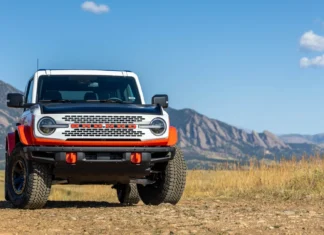
CHECK THE WEATHER FIRST
First things first, adjust for weather conditions. Their rig has an onboard weather station, measuring things like atmospheric pressure, humidity, and temperature. The guys then plug in the weather conditions into a spreadsheet program to get an idea where to start with the engine. Optimization of the compression ratio, what the booSts needs to be, ignition timing, air-fuel ratio, and so on and so forth are all related to the ambient conditions at the track.
TEST RUNS
Once these initial parameters have been established, they make a preliminary run. An onboard data recorder records about 60 different variables from wheel speed to exhaust temperature to boost, everything that needs to be looked at in order to make the car go as fast as possible is examined, and then adjustments are made to the initial parameters based off of real-world feedback.
ADJUST ACCORDINGLY
Bandimere Speedway is 5,800 feet above sea level. Racing here is very different than racing at at sea level. Being up this high, the team only has about 82 percent of the air they have to work with at sea level. To put it bluntly, the team can’t compensate completely for this lack of air, but they do take every single step possible to squeeze the maximum amount of horsepower out of finely crafted engine block that will last no more than a couple runs.
The main way they do this is with an increase in engine boost. They lean out the fuel delivery. They increase the clutch application, and increase the compression ratio. Usually they run about 6:1 at sea level, and at altitude they run about 7:1. One crazy way they do this is by varying head gasket thickness; a thinner gasket means higher compression. A compression ratio of 6:1, at first glance is very low. But the first thing to remember is that these engines are under 60psi of boost.

DIAL THE FUEL MIXTURE
The second thing to know is that nitromethane makes up for that low compression. The fuel these dragsters use is mixture of nitromethane and methanol. Regulations state that the nitromethane cannot exceed more than 90 percent of the fuel mixture. At the finish line, the cars are checked with a hydrometer to ensure they are not running about 90 percent nitromethane. To stay within this tight directive, they usually run below the 90 percent as the calibration of their hydrometer may be different from the official’s hydrometer. At sea level they run about 88.7 percent nitromethane, so that they are within the regulation parameters but this gives them a small window to increase the nitromethane content if they need just a bit more power, which is exactly what they do at higher altitudes.
In case you are wondering, this sort of mix doesn’t really have an octane rating.
SPEED IS ALL ABOUT RPMS
The onboard accelerometer measures a force somewhere around 5 Gs, which is 2 more than what an astronaut experiences upon launch. Within 1 second, the car reaches speeds of well over 100 mph. In about 3.2 seconds when the car is halfway down the strip, its speed reaches about 280 mph. In the last few hundred feet is when the car is at its fastest. Venable’s and Knudsen’s team holds the current record of 338 mph.
These cars have no transmissions, with the clutch operating like a mini bike’s or a go-kart’s would. So how do these cars get to 300 mph with one gear? The clutch slips until the wheel speed catches up with the engine speed, and the gear ratio becomes 1:1. This happens usually right about halfway down the strip, and whatever power the engine is producing proceeds uninterrupted through the driveshaft and onto the tarmac. However fast the engine can be made to rev up is as fast as the car can be made to go, with a peak of about 8,600 rpm, which peak torque occurring around 7,000 rpm.

FIGURE OUT THE TIRES
As far as tires go, only one mandated tire is allowed. The biggest thing to take a look at when it comes to tires is the durability and flexibility sidewalls. They need to be able to flex with a proper spring rate as the tire folds back on itself upon the initial acceleration, then spring back, all while not compromising the structural integrity of the tire under a huge amount of torque.

























